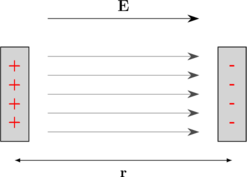1. Electric Potential
Electric potential of a point r meter from a charge:

\(V = k \: \dfrac{Q}{r}\)
2. Electric Potential Difference
Electric potential difference between 2 points:

\(\Delta V = V_2 - V_1\)
\(\Delta V = k \: \dfrac{Q}{r_2} - k \: \dfrac{Q}{r_2}\)
\(\Delta V = k \: Q \left(\dfrac{1}{r_2} - \dfrac{1}{r_1}\right)\)
If two points have different potential, higher potential symbolized with (+) and lower potential with (−).
Between two points which have different potential, electric field will produced.

\(\Delta V = E \:.\: d\)
2. Electric Potential Energy
electric potential energy between two charges:
\begin{equation*} E_p = k \: \frac{q \: Q}{r} \\ Joule & = q \: V \end{equation*} A charge can move from one point to another which have different potentials. The work done by the charge is:
\begin{equation*} \begin{split} W & = \Delta E_p \\\\ W & = E_{p_2} - E_{p_1} \\\\ W & = q \: V_2 - q \: V_1 \\\\ W & = q (V_2 - V_1) \\\\ W & = q \:.\: \Delta V \end{split} \end{equation*}
Exercise

